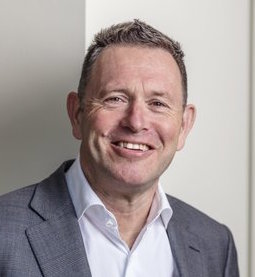
Faraday Grid, co-founded by Australian Andrew Scobie, has set up shop in the UK. Its mission is to create “fit for purpose” energy systems that can accommodate large volumes of decentralised, intermittent generation without collapsing.
The company claims it can massively increase grid capacity to carry renewables at no additional cost, while solving network volatility.
Other firms are currently doing clever things to better gauge inertia and its impacts, but Scobie says his company’s technology can take things a step further.
“We don’t measure the problem,” he states. “We solve the problem.”
If energy companies buy into the vision – and Faraday Grid technology can be proven to work at scale – the firm believes it can fundamentally change global energy infrastructure.
A bold claim, given grid operators are not known for taking risks on new technology.
Scobie, the firm’s CEO, accepts that at face value it’s not an easy sell.
Attitude adjuster
“Yes, they are risk averse. We’re talking about the nervous system of our economy. Energy impacts on everything. So people should be both cynical and sceptical, because the last thing you want to do is disrupt the energy system,” he says.
“But that is the reality – it is going to be disrupted. Renewables will destabilise the grid. That is Ofgem and Beis saying that, not me. The grid is becoming increasingly fragile,” says Scobie, and without intervention “it will crash”.
In that sense, technological change is no longer a risk for utilities, Scobie suggests. ”Business as usual is the risk.”
“We are finding that the distribution network operators and those involved in the energy system as a whole are enormously welcoming about things that are going to reduce risk.”
The Faraday Exchanger
The company’s premise is based upon what it calls the Faraday Exchanger. It’s a piece of kit that replaces network transformers, which the company emphasises were not built for distributed energy and bi-directional power flows.
As such, Scobie says transformers are no longer fit for purpose and must be swapped out for “something smarter and much more dynamic”.
He bills the Exchanger as “the fundamental enabling technology” of a dynamically balanced grid. “It’s the equivalent of the router to the internet,” he suggests.
The company’s literature describes the Faraday Exchanger as: “A managed, high speed, power flow control device that dynamically maintains target voltage, frequency and power factor efficiently over a range of operation”.
According to the firm, the Exchangers require no external communications and are fully autonomous, and can be dropped into grids incrementally, under existing regulations, without breaking everything.
The Faraday Grid
Swapping out transformers for Faraday Exchangers (which Scobie says will cost the same as transformers, validating the firm’s “no additional cost” claim) enables the Faraday Grid.
The company’s literature describes the Faraday Grid as: “An autonomous, responsive, electrical meta-network, agnostic to generation and consumption, with its own inertia, enabling more productive, resilient and stable electricity transfer.”
Is anybody buying this?
Faraday Grid is backed by Canadian renewables developer and investor, Amp. Scobie says Amp sees “immediate value” in the technology’s ability to stabilise microgrids, which can be much more susceptible to variations in power quality and quantity.
“Amp runs domestic and commercial microgrids for some of the largest commercial companies in the world, so that is a direct [commercial] pathway for us,” says Scobie.
He believes the company’s technology has applications across the energy system, but thinks that in the UK, distribution network operators (DNOs) will be initial customers, given the volume of transformers on their networks and the impact of dynamic demand on their operations.
Scobie says the company is in discussions with five of the DNOs, but talks with Scottish Power Energy Networks – and another network south of the border – are probably the most advanced.
However, the company says its first deployments will be with Amp in overseas markets next year. In the UK, it will make use of the Power Networks Demonstration Centre in Glasgow to optimise design architecture for UK grids before moving into commercial trials.
Any barriers?
Should those trials prove successful, there are no regulatory barriers to deploying Faraday Exchangers, says Richard Dowling, the company’s head of government affairs and chief economist.

“One of the design characteristics [of the Faraday Grid] is that it can be built on individual basis and can therefore solve very localised problems. For example, in an area with a lot of rooftop PV, the local utility may be struggling to control voltage. You can put a Faraday Exchanger in that location while being compatible within the existing grid,” says Dowling.
“So it does not require any regulatory amendment for us to roll out the technology, which is fundamental to the approach we have taken.”
Equally, removing the requirement for a large software layer by making the Exchangers intelligent, removes the cost and scalability problems that have scuppered attempts to rollout smart grids in the past, Dowling adds.
“It allows utilities to iterate our technology, which receives all the information it needs to self-manage from the electricity signal itself.”
What they say:
“We are fundamentally a change to the common denominator of the energy system. We, in a sense, come from the future. Our backgrounds are in energy systems and complex manufacturing systems globally,” says CEO Andrew Scobie.
“We identified in our Australian utility clients that there was a very substantial problem in the physics and economics of the energy systems brought about by competing political agendas [the trilemma of affordability, security of supply and decarbonisation].
“The utilities sector in Australia has suffered in recent times, with four recent grid crashes. We worked with very large utilities over periods of time and while we could see the problem, none of the existing technology pathways could solve it, either technically or economically.
“Most people focus on intermittency. But at least half of the problem is physics, maintaining system balance, which is not about intermittency – it is volatility that knocks over grids. So to enable all of the other solutions that are imperative to our future, you must first solve energy system stability.
“The Faraday Grid is designed to solve that … and so far, every door that we have knocked upon is open.”
Emergent trading platform
Faraday Grid is also building a transactional platform called Emergent, which is designed to sit on top of its smart grid and enable dynamic trading to help balance the grid using price signals. The firm believes this will complement its grid architecture by engaging consumers and generators and enabling them to trade power using dynamic pricing.
According to company literature, it is “a system of control that balances supply and demand across the entire energy system, using price as the key operational mechanism.”
Related stories:
UK system inertia measured for first time
As solar generation makes history, National Grid starts to feel the burn
Government sets out smart energy plan, moots peak pricing for all
UK loses 11.4GW of coal and gas fired generation in three years
Ofgem paves way for major changes to energy system rules and charges
Solar onshore wind and biomass add 4GW to UK generation capacity in 2016
Solar PV hits 12GW, further 3GW in planning
Ofgem mulls what to do if people don’t engage with smart meters
Society must rethink its approach to electricity use, says Ofgem networks chief
Click here to see if you qualify for a free subscription to the print magazine, or to renew.
Follow us at @EnergystMedia. For regular bulletins, sign up for the free newsletter.



